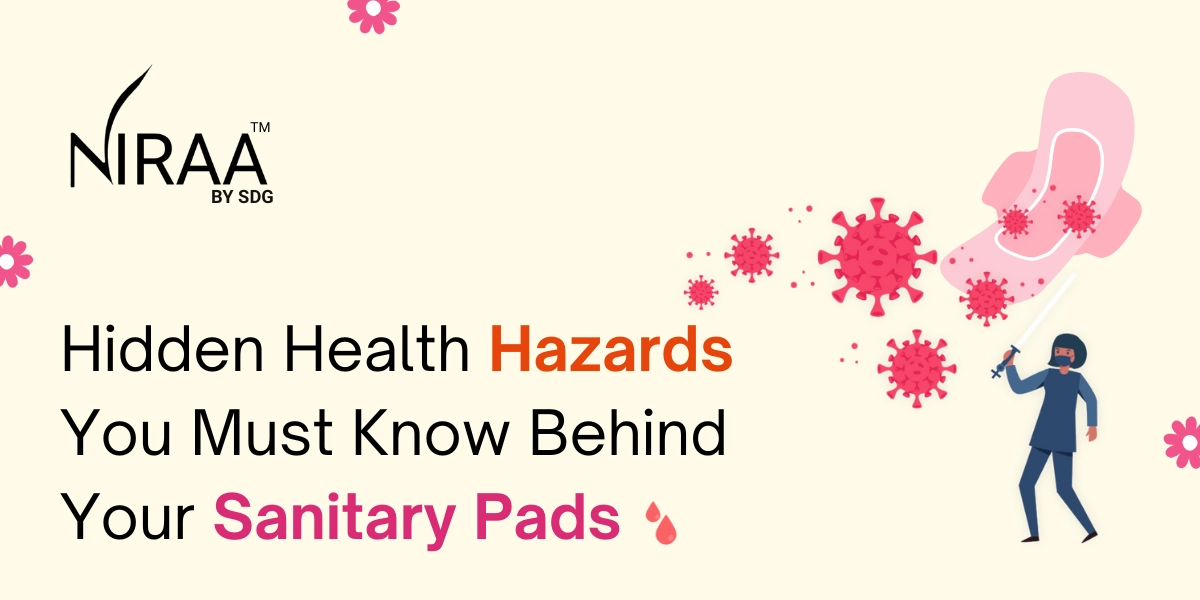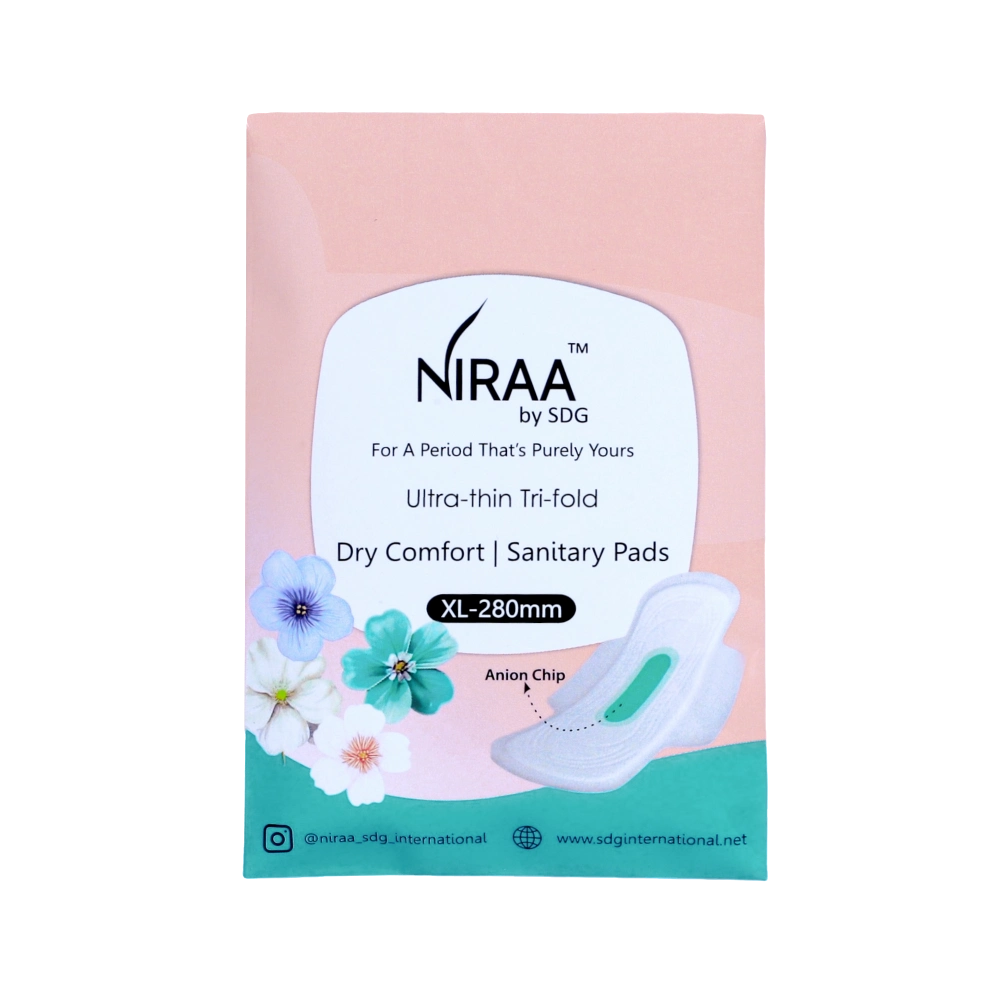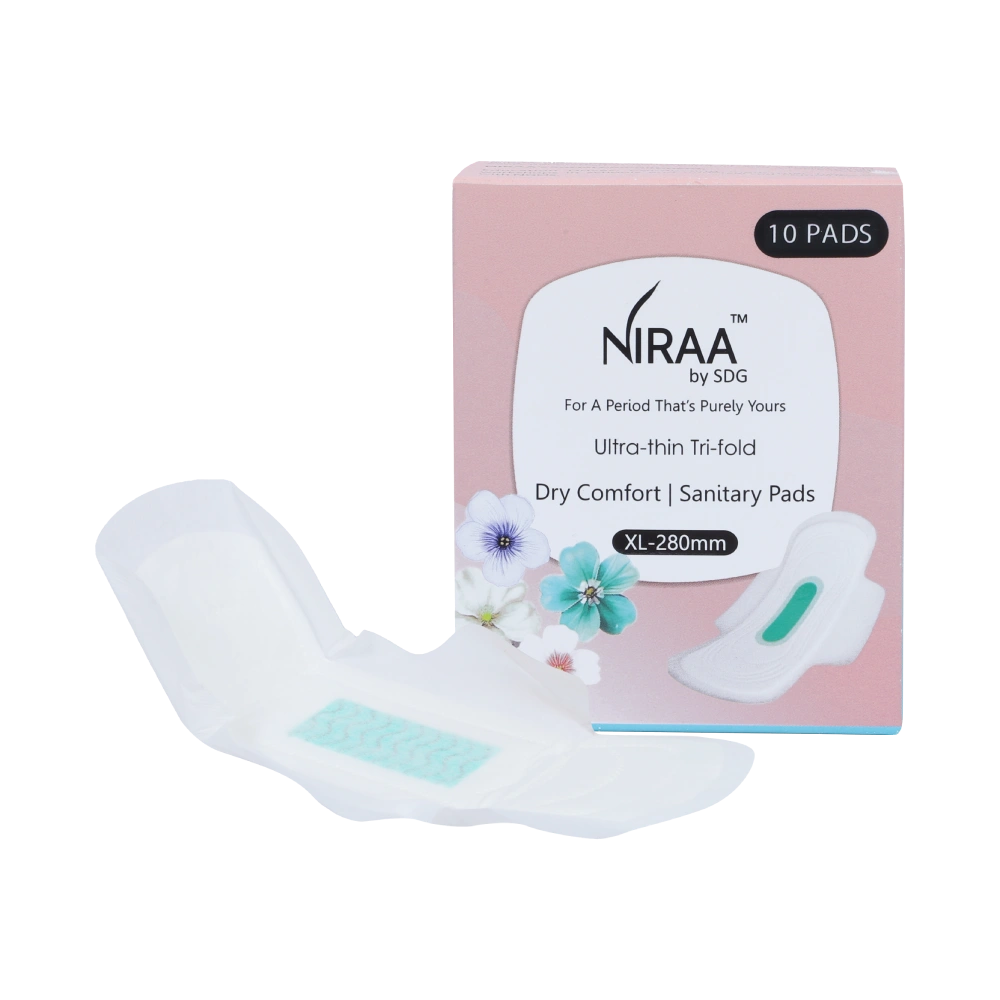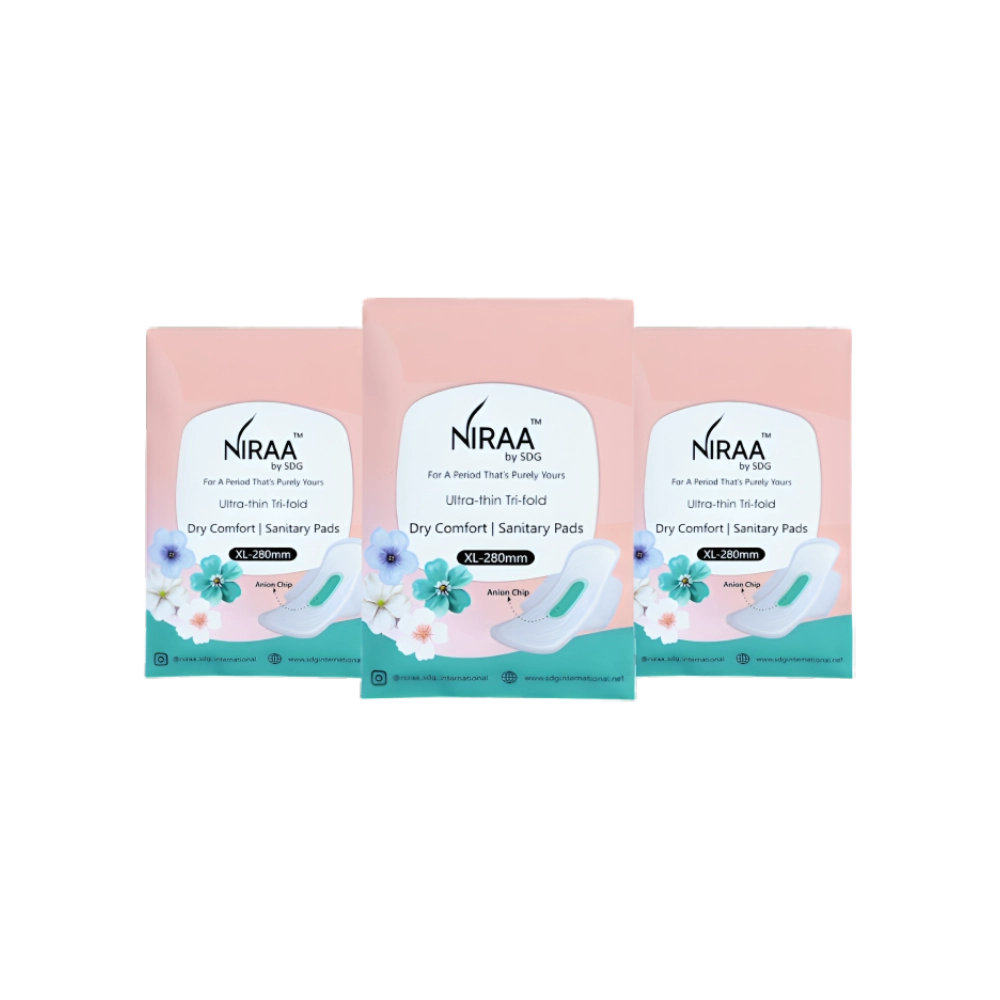Menstrual hygiene is more than just a personal routine. It is a vital part of a woman’s health, comfort, and dignity. In India, the National Family Health Survey (NFHS-5) shows that nearly 78% of women now use hygienic menstrual methods, which reflects a growing awareness about safe menstrual practices.
However, not all sanitary pads are equally safe. If a pad is made from inorganic materials, there are health hazards that need to be considered well on time. Some pads may contain chemicals, low-quality materials, or poor absorbency, which can lead to rashes, irritation, infections, and discomfort.
At NIRAA by SDG, we believe every woman deserves safe, skin-friendly, and comfortable protection without compromise. Being aware of what your pads are made of and any hidden health risks helps you make smarter and safer choices for your health.
Health Risks of Low-Quality Sanitary Pads
Even though low-quality sanitary pads may be widely available, they can have hidden health risks that affect women’s comfort and well-being. These pads often compromise on materials, absorbency, and safety standards, which can lead to several issues.
Harmful Chemicals and Toxins
Some low-quality pads contain bleaching agents, dioxins, and synthetic fragrances. While these chemicals are added to make pads look clean and smell fresh, they can irritate sensitive skin. Prolonged exposure may also affect hormonal balance and reproductive health.
To stay safe, follow these tips:
- Choose pads that are toxin-free.
- Opt for certified and tested products that meet safety standards.
Irritation, Allergies, and Infections
Pads with poor absorbency or rough materials can cause:
- Skin irritation and rashes
- Allergic reactions
- Bacterial growth leading to infections
Studies in India, including research by the Vidarbha Institute of Medical Sciences, show that poor menstrual hygiene and the use of low-quality pads contribute significantly to reproductive tract infections.
Absorbency Issues and Leakage
Low-quality pads often fail to absorb properly, which can cause:
- Leaks and discomfort
- Embarrassment in public
- Increased risk of infections if pads are not changed frequently
The Long-Term Impact
Repeated use of low-quality pads may lead to:
- Persistent skin irritation and discomfort
- Potential long-term effects on reproductive health due to chemical exposure
Investing in high-quality, safe sanitary pads ensures both comfort and protection from these hidden health hazards.
Why Material Quality Matters
The materials used in sanitary pads play a crucial role in women’s health, comfort, and overall menstrual hygiene. Low-quality pads often use rough or synthetic materials that can cause irritation, rashes, and discomfort. Knowing what to look for in a pad can help women make safer choices.
What Makes a Pad Safe and Comfortable
Good-quality pads are made from:
- Soft and breathable materials that allow airflow and prevent sweating
- Absorbent layers that lock in liquid and keep the surface dry
- Safe adhesives that do not cause itching or burning
Low-quality pads may use plastic-like or rough materials that trap heat and moisture, causing irritation, especially during long hours of use.
Importance of Standards
In India, the Bureau of Indian Standards (BIS) checks that sanitary pads are safe and absorbent.Pads that follow these standards are tested for:
- pH balance
- Comfort
- Material safety
Tips for Choosing the Right Pad
When picking a pad, always look for:
- “Skin-Friendly” on the pack
- Pads that feel soft, not plastic-like
- Trusted brands that follow safety and hygiene standards
Using pads made from safe and breathable materials ensures better comfort and reduces the risk of irritation or infections.
Chemical Exposure & Long-Term Health Concerns
Even though some pads may seem cheaper, low-quality pads can expose women to harmful chemicals that may affect health over time. This is why choosing safe and tested sanitary pads is so important.
Dioxins, Bleaching Agents, and Volatile Compounds
Many low-quality pads are treated with chlorine-based bleaching agents, which can leave tiny amounts of dioxins, chemicals linked to hormonal imbalance and other health issues.
Other substances, like volatile organic compounds (VOCs) from adhesives and synthetic layers, can irritate the skin and sensitive areas.
To stay safe and healthy:
- Choose bleach-free menstrual pads.
- Use pads labeled toxin-free
These small steps help reduce chemical exposure and protect long-term health.
Long-Term Health Effects and Reproductive Risks
Some low-quality sanitary pads contain chemicals like dioxins and phthalates, which can cause serious health problems. Using such pads for a long time may disturb the body’s natural hormones and affect reproductive health. Studies also show that these toxins increase the risk of infections and other menstrual health issues.
To protect yourself:
- Choose certified sanitary pads that are free from harmful chemicals
- Pick skin-friendly and tested materials for better hygiene and comfort.
Using safe pads helps maintain long-term health and gives you peace of mind during periods.
Importance of Transparency and Eco-Labeling
Knowing how pads are made helps women make safer choices. Clear labeling builds trust and ensures you know what you are using.
Pads with eco-labels mean that they are:
- Free from harmful chemicals like dyes or toxins.
- Made under safe, and hygienic manufacturing processes
- Better for both your health and the environment.
In India, more brands are now promoting eco-friendly sanitary pads, helping women pick products that care for their well-being and the planet. Choosing such pads is a small step that makes a big difference.
Proper Usage and Hygiene Habits
Even the best sanitary pad can cause discomfort or health problems if not used properly. Good menstrual hygiene practices are just as important as choosing a safe pad. Knowing how to use, change, and dispose of pads properly can prevent infections and keep you comfortable throughout your period.
Best Practices for Pad Changing and Disposal
- Change your pad every 4 to 6 hours, or more often if you have a heavy flow.
- Always wash your hands before and after changing pads.
- Wrap the used pad in paper and throw it in a covered dustbin.
- Never flush pads in the toilet as it blocks drainage and harms the environment.
Following proper disposal practices is also part of the Swachh Bharat Mission, which emphasizes health and cleanliness in India.
Benefits of High-Quality Pads for Comfort and Hygiene
High-quality pads provide more than just protection.They boost confidence and keep you comfortable all day.
- Provide consistent absorbency, keeping you dry
- Offer odor control for confidence during school, college or work
- Made with soft, skin-friendly layers to prevent irritation or rashes
- Strong absorbent cores ensure hygiene and comfort
- Choosing quality pads reduces common menstrual issues and enhances confidence
Safer Menstrual Hygiene Alternatives
Some women prefer eco-friendly options, which are safe for both health and the environment:
- Organic sanitary pads made from natural fibers, free from harmful chemicals
- Reusable menstrual pads that are environmentally friendly
Both alternatives require proper cleaning and storage to maintain hygiene and comfort.
Global Standards & Safe Choices
Sanitary pads are essential hygiene products, which is why their safety and quality are regulated across the world. Understanding these standards helps women make smarter choices and pick brands like NIRAA that truly care about their well-being.
Regulations and Standards for Sanitary Products
In India, sanitary pads are treated as consumer hygiene products, not medical products. They must meet specific quality and safety rules before reaching the market. The Bureau of Indian Standards (BIS) checks factors like absorbency, pH level, and material safety to ensure pads are safe for everyday use.
Globally, organizations like the World Health Organization (WHO) and the International Organization for Standardization (ISO) set guidelines for safe production, proper labeling, and material testing. Brands that follow these standards show real care for women’s hygiene and comfort.
Why Choosing Certified and Tested Pads Makes a Difference
Certified sanitary pads go through strict testing for absorbency, comfort, and chemical safety. This ensures every pad works reliably and is free from harmful substances. By choosing certified or tested pads, women can stay confident, comfortable, and safe.
NIRAA sanitary pads are made under controlled, hygienic conditions and go through multiple quality checks to meet these standards. Every pad reflects care, trust, and attention to safety.
Environmental Impact of Disposable vs Reusable Pads
Disposable pads are widely used but contribute significantly to menstrual waste in India. According to the Ministry of Housing and Urban Affairs, over 12 billion pads are discarded every year, creating plastic pollution and landfill issues. Eco-friendly alternatives, like reusable menstrual pads or sustainable period products, can reduce this burden while keeping hygiene intact.
Conclusion: Choose Safety, Choose Yourself
Sanitary pads may seem like just another purchase, but choosing the wrong ones can quietly affect your comfort, health, and peace of mind over time. Every woman deserves protection that is safe, soft, and gentle on the skin, not filled with hidden chemicals or poor materials that cause irritation or discomfort.
By choosing trusted brands like NIRAA By SDG that meet quality standards, you not only safeguard your own health but also support a growing movement toward better menstrual hygiene and awareness in India. Remember, your body deserves care, not compromise, because menstrual hygiene is not a luxury, it’s your right.
Final Tip: Always read the label, check for eco-friendly options, and pick pads made with breathable, non-toxic materials to stay comfortable and healthy throughout your period.




